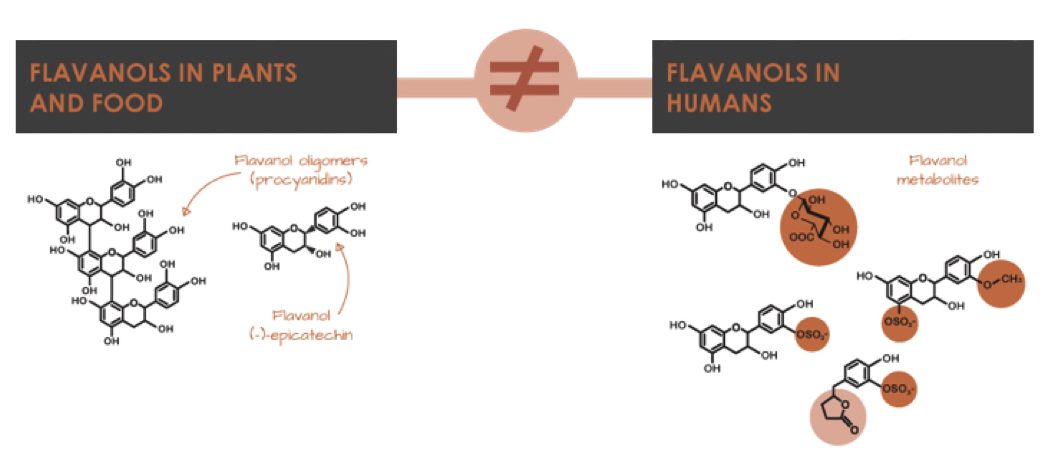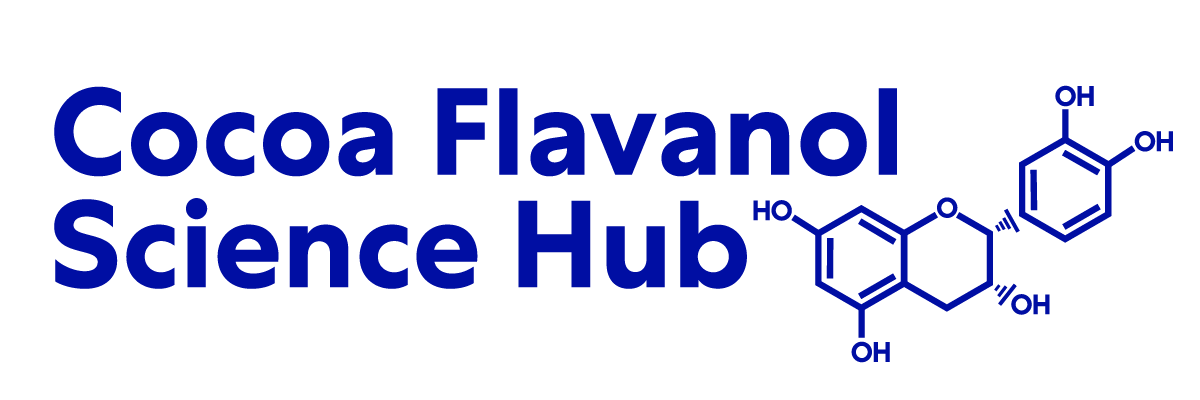Going Beyond Essential Nutrients: The Role Of Bioactives In Assessing The Impact Of Food On Health
Friday, July 1, 2016
Going Beyond Essential Nutrients: The Role Of Bioactives In Assessing The Impact Of Food On Health

IN BRIEF
- Bioactives are natural food constituents, widely studied for their potential benefits in maintaining health and preventing disease—but despite this, we have significant gaps in our understanding of the role of bioactives in health and nutrition.
- A paper published today in Nature Scientific Reports looks at the flavanol epicatechin in order to better understand the absorption, distribution, metabolism, and excretion (ADME) of this bioactive in humans.
- The findings highlight the importance of ADME data in the study of bioactives. The findings of this study will impact how scientists assess the health benefits and safety of flavanol intake, investigate the molecular mechanisms of flavanol bioactivity in cell and tissue cultures, and evaluate data from epidemiological studies.
- Moreover, the outcomes of this research will have wider implications for the study of other bioactive constituents in foods.
KEY FINDINGS
- Epicatechin is extensively metabolized in the human body, and more than 20 related compounds were found in blood and urine. No unmetabolized epicatechin was found outside the digestive tract.
- Epicatechin does not act as a direct antioxidant in the body.
- Humans metabolize epicatechin differently than rats and mice.
Demographics are changing. Life expectancy and the average age of populations worldwide is increasing. As age is a key risk factor for the development of various diseases, getting older means being at greater risk of cognitive decline, cardiovascular disease and other age-related disorders.
Representing a main lifestyle factor that impacts long-term health, the role of diet in health maintenance and disease risk reduction for healthy aging cannot be overestimated. Therefore, a more holistic and evidence-based understanding of food and health that moves beyond essential nutrients, and continues to shift the focus of dietary guidelines from mainly preventing nutrient deficiencies to life-long health maintenance and age-related disease prevention is needed.
In this context, a comprehensive understanding of the role of bioactives for health is key. Bioactives are naturally occurring constituents in foods that influence various processes in the body. While not essential for human life, many bioactives like lycopene, lutein, flavonoids and isoflavones have been shown to have a potential role in maintaining health and preventing or delaying the onset of disease.
Our current knowledge of bioactives is insufficient
Our understanding of food constituents and their impact on health is, at the moment, largely limited to nutrients essential for human life, which include the macronutrients (water, protein, fat and carbohydrate), the vitamins (like Vitamin C), and various minerals (like iron and zinc). The existing evidence for their role in human health is substantial and has resulted in the establishment of essential nutrient requirements and recommended essential nutrient intakes.
In contrast, what we know today about bioactive food constituents is far more basic—even though research on bioactives currently accounts for a significant portion of nutrition research spending. There currently exist no established intake recommendations for most bioactives, nor is there a formal process by which bioactives are evaluated scientifically. Consequently, neither scientists called upon to provide advice, nor consumers who are selecting products based on the bioactives they contain, can rely on a standardized, science-based framework to inform dietary recommendations on the intake of bioactives.
The quality of bioactives research and our level of knowledge would be enhanced if we were to apply scientific standards similar to those used for essential nutrients. A better understanding of bioactives could enable us to create intake recommendations similar to the recommended daily nutrient intakes for essential nutrients. An evidence-based recommendation for bioactives could guide public health professionals, inform consumers regarding how much of a particular bioactive they should be consuming in their diet, and could help farmers grow fruit and vegetables that are rich in essential nutrients and recommended bioactives.
An essential step in studying bioactives is to understand what happens to these compounds after their consumption, i.e. how they are absorbed, distributed, metabolized and excreted (ADME) by the human body.
New study explains the “ADME” of epicatechin in humans
The paper published today in Nature Scientific Reports begins to bridge the gap in our knowledge of bioactives, and it highlights the importance of understanding the ADME of food constituents.
Researchers from the University of California, Davis, the University of Reading, UK, and Mars, Incorporated selected a widely researched bioactive, called (−)-epicatechin, which is found naturally in tea, apples, pears, grapes, various berries and fresh cocoa beans (NB: chocolate contains only negligible amounts of (−)-epicatechin). Epicatechin is one of the most commonly consumed flavanols, and belongs to a wider family of compounds called polyphenols.
Applying a gold-standard approach, the investigators asked participants in the study to consume a drink containing a version of epicatechin with a slight modification to one of the carbon atoms ([2-14C](−)-epicatechin). This allowed the researchers to precisely track how the compound is absorbed, distributed, metabolized and excreted, and for how long it is present in the human body.
Epicatechin is changed by the body
The study showed that epicatechin was rapidly metabolized into more than 20 different compounds after it entered the human body. Interestingly, by measuring how long it took for these compounds to appear in the bloodstream, it was possible to see that much of this metabolism depended on processes specific to the gut microbiome.

The study also confirmed that epicatechin’s metabolism into 20+ different compounds stops it behaving as a direct antioxidant. In vitro, the form in which epicatechin is present in plants and foods “neutralizes” free radicals that, inside the body, are believed by some to damage DNA and cells. Because epicatechin is dramatically altered through metabolism, the forms of epicatechin actually absorbed by the body could not be demonstrated to neutralize free radicals and therefore were not acting as antioxidants.
However, consuming epicatechin is linked by a significant body of research to various cardiovascular health benefits. The fact that none of the epicatechin forms found in plants were found in the bloodstream or urine tells us that epicatechin itself could not have directly mediated these benefits but, instead, one or more of its “metabolites,” which were present and identified in the body, must be causing the improvements in cardiovascular function observed in previous studies.
Hundreds of studies have investigated the health benefits of polyphenolic bioactives in vitro using cell and tissue cultures in the past. But, not fully aware or appreciative of the role of ADME on the forms of polyphenols present in the human body, most researchers use the form of the compound as present in plants and foods for their investigations, even though almost all polyphenols are now known or suspected to be subject to extensive metabolism. Only a handful have looked at the effects of the metabolites.
The study of unmetabolized epicatechin in vitro is therefore not useful for understanding the effects of the compound in the body. Investigating the biological effects of polyphenols in vitro requires the use of metabolites, as exemplified by this work on epicatechin where no amount of the compound was present in blood or urine in the same form in which it was originally present in plants or foods.
Differences between species in metabolizing epicatechin
Laboratory rats and mice are often used to investigate safety of nutrients and drugs for humans. Indeed, the vast majority of investigations to date on the safety of polyphenol intake involve rodent models, rather than humans.
Rodents are used in toxicological studies for a variety of reasons but, crucially, it is important that “species equivalence” in ADME exists between humans and rodents. That means rodents and humans must absorb, distribute, metabolize and excrete the substance being tested in similar ways. If such species equivalence does not exist, rodents are likely unsuitable or insufficient for testing the safety of that particular substance.
To date, species equivalence between rodents and humans in the ADME of flavanols has been assumed, but never established. The paper published today compares human data with rat and mouse data and shows that equivalence in fact does not exist. The forms and relative amounts of structurally related epicatechin metabolites in the bloodstream differed between humans, rats and mice.
Mice and rats may therefore be unsuitable or insufficient for research aimed at assessing human efficacy and safety of flavanol consumption. This may also extend to other members of the large family of polyphenols, which suggests the use of rodents in future safety studies of flavanols and other polyphenols will need to be carefully evaluated.
This finding is novel for flavanols but not for many other food constituents and drugs where species-dependent differences in metabolism have been observed before. The concept is not new and is already embedded in scientific and regulatory frameworks that guide the assessment of efficacy and safety of foods and drugs in humans.
Conclusion
The outcomes highlight the importance of ADME data in the study of bioactives. The findings of this study will impact how scientists and regulators assess the evidence on the health benefits and safety of flavanol intake, investigate the molecular mechanisms of flavanol bioactivity in cell and tissue cultures, and evaluate data from epidemiological studies. Further, the outcomes of this research will have wider implications for the study of other bioactive constituents in foods, and can thus contribute to advancing a science-based framework for understanding the role bioactives can play in promoting health.
Reference
Javier I. Ottaviani, Gina Borges, Tony Y. Momma, Jeremy P.E. Spencer, Carl L. Keen, Alan Crozier and Hagen Schroeter. The metabolome of [2-14C](−)-epicatechin in humans: implications for the assessment of efficacy, safety, and mechanisms of action of polyphenolic bioactives, Nature Scientific Reports, Online
Get more details and access the original paper about this study








